Let us put Chapter 6: "The Arab Raid"
at this point in the discusssion so as to achieve greater continuity at
the scenes in Opar.
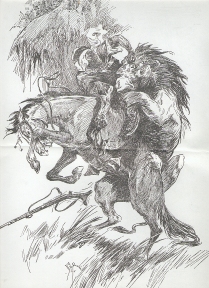 With Tarzan absent from the Estate Zek makes his move to obtain Jane.
The brave Waziri warriors rally around Jane putting up a fierce resistance.
For whatever reason Tarzan hasn't armed them with the latest repeating
rifles and perhaps a Gatling Gun preferring they fight their battles with
spears; hence they are no match for Zek whose men are armed with some woefully
outdated firearms. We aren't even told whether they're Snyders.
Burroughs just calls them "long guns."
With Tarzan absent from the Estate Zek makes his move to obtain Jane.
The brave Waziri warriors rally around Jane putting up a fierce resistance.
For whatever reason Tarzan hasn't armed them with the latest repeating
rifles and perhaps a Gatling Gun preferring they fight their battles with
spears; hence they are no match for Zek whose men are armed with some woefully
outdated firearms. We aren't even told whether they're Snyders.
Burroughs just calls them "long guns."
Jane herself is armed with what seems
to be a repeating rifle. While there are those who refer to Jane
as wimpy she is far from wilting here as she gamely fires through the closed
door.
It is difficult to determine ERB's intent here.
In 1903-04 when Emma traveled to the wilds of Idaho with her husband she
was far from the frontier type. ERB undoubtedly wanted her to be the dauntless
frontier woman perhaps as was the wife portrayed in the Virginian but he
discovered she was a citified fashion queen. Perhaps here he is demonstrating
to Emma what he had wanted her to be.
The Estate is fired as it will be again three
years hence when the Germans arrive. At that time ERB led us to believe
that Jane was murdered while here she is about to be taken far away.
In ERB's troubled mind it would appear that he wanted to be rid of Emma.
He would actually say he always wanted to be rid of her twenty years hence.
Oblivious of the fate of Jane Tarzan is in
far away Opar loading the remaining faithful Waziri with the oddly shaped
gold ingots.
Werper has followed him into the vaults.
As an allegory Werper in this place can represent Ogden McClurg.
The vaults can represent ERB's mind where the wealth of his imagination
is stored. Thus the publisher is taking what is rightfully ERB's
labor.
In actuality Ogden McClurg was seldom in Chicago.
He was a naval officer who was in the Caribbean most of the time coming
back briefly and then when The Great War broke out he became involved in
those operations. The manager Joe Bray seems to have been the responsible
person. I haven't been able to ascertain McClurg’s position while
I have been told the records for McClurg's were destroyed so that may be
impossible. I have gone through the correspondence between McClurg's,
A.L. Burt and Grosset and Dunlap in the archives of the University of Louisville.
There seems to have been an agreement between McClurg’s and G&D to,
how shall I say it, defraud Burroughs of royalties. If Burroughs
was the best selling author of the time he is represented to be his royalty
checks were ludicrously small, by the late thirties five, six and seven
dollars per title. Hardly worth either McClurg's or G&D's bother
if accurate. One is at a loss to understand why they clung so obstinately
to the titles. One compares such small checks with the enormous
sales of the 1960s. You can draw your own conclusions but it
definitely seems there are some unsolvable contradictions.
Burroughs always believed he was being cheated.
Based on the evidence I have seen I have to agree with him.
The gold has been brought to the top of the
shaft. Tarzan goes back for a last look when the roof literally caves
in. An earthquake occurs; a portion of the roof lands on Tarzan's
head putting him out. Werper who was in the same place with Tarzan
is uninjured. Unable to go forward he takes the candle stub fleeing
down the corridor toward Opar. In this instance he appears almost
as a doppelganger of Tarzan.
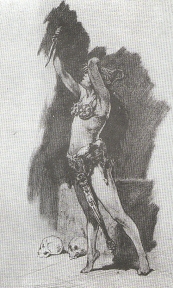 Tarzan when locked in a cell on the previous occasion had removed the bricks
in the wall opening into this corridor. Werper now traces Tarzan’s
steps in reverse. Coming to the well he makes the same leap with
with same success. Removing the bricks he retraces Tarzan’s steps
back up into the sacrificial chamber. Here the little hairy men seize
him tossing him onto the altar where La awaits. Duplicating the sacrifical
scene with Tarzan she is about to plunge the knife into Werper’s breast
when the air is shattered by a deafening roar. A lion has announced
his presence in the chamber. The little hairy men flee, La faints
and Werper prays.
Tarzan when locked in a cell on the previous occasion had removed the bricks
in the wall opening into this corridor. Werper now traces Tarzan’s
steps in reverse. Coming to the well he makes the same leap with
with same success. Removing the bricks he retraces Tarzan’s steps
back up into the sacrificial chamber. Here the little hairy men seize
him tossing him onto the altar where La awaits. Duplicating the sacrifical
scene with Tarzan she is about to plunge the knife into Werper’s breast
when the air is shattered by a deafening roar. A lion has announced
his presence in the chamber. The little hairy men flee, La faints
and Werper prays.
We know this story because it is ERB's favorite
theme written in many variations.
ERB leaves Werper at the altar and returns
to Tarzan who we last saw lying on the floor in a spreading pool of blood.
The sequence in Opar recapitulates the main psychological traumas in ERB's
life in one of its many variations. The story changes and evolves
but the facts remain the same. The overriding trauma here was ERB's
bashing in Toronto in 1899. The blow from the sap or pipe had a fixating
effect on ERB. I'm sure he relived the situation over two or three
times every day. It remains to be discovered if he blamed Emma for
it. Had he not been competing with Martin for her hand the blow would
never have happened. Here he couples the memory of the blow with
the abduction of Emma.
Inert for a period of time he recovers but
has lost his memory. A usual occurrence in periods of great stress
for ERB. He didn't think he lost consciousness in Toronto but he
was knocked down having his scalp torn so that he was covered in blood
by the time he arrived at the hospital. I think he did lose consciousness
although he may not have been "out cold."
I compare the situation with one of mine.
At fifteen I was ice skating when I saw a boy scoot between two girls holding
hands at arm's length. I thought I would emulate him but the two
girls closed up as I came from behind. I was better at starting than
stopping. My legs flew up and I landed on the back of my head.
I literally saw stars, five pointed colored stars in a burst of light.
I can still recall the sound of my skull striking the ice. It was
an odd sound. I never thought I lost consciousness but I remember
opening my eyes so I must have been unconscious for some seconds at least.
I suspect that ERB as he fell lost consciousness for at least a few seconds
if not longer. Here in Opar he has Tarzan knocked cold for some time
which must have been the way he had felt. ERB had fairly serious mental
problems for at least a couple decades. While he doesn't record losing
his memory as such he has the hero of Girl
From
Farriss's
who received a blow duplicate to that received by himself, Ogden Secor,
walking past friends as though he didn't know them. A form of memory
loss.
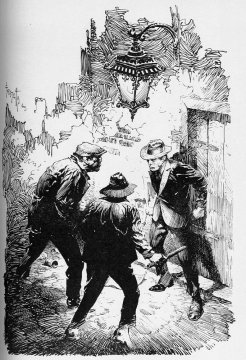 There is no story of Burroughs in which the main
character doesn't get bopped once or twice. This was noticed by Raymond
Chandler, the creator of Philip Marlowe, who wrote a semi-dissertaion on
bopping in one of his stories. Chandler had read Burroughs extensively.
He speculated that no man could survive so many bashings as Tarzan received.
Probably true. Chandler then proceeds to have a character bashed
twice in succession. Chandler preferred the lump behind the ear which
produces euphoric dreams.
There is no story of Burroughs in which the main
character doesn't get bopped once or twice. This was noticed by Raymond
Chandler, the creator of Philip Marlowe, who wrote a semi-dissertaion on
bopping in one of his stories. Chandler had read Burroughs extensively.
He speculated that no man could survive so many bashings as Tarzan received.
Probably true. Chandler then proceeds to have a character bashed
twice in succession. Chandler preferred the lump behind the ear which
produces euphoric dreams.
At any rate Tarzan recovers while dimly remembering
his "heavy war spear" that he searches for. It is interesting that
Tarzan never adopts modern weapons even though Jane had a repeater and
one as knowledgeable as Tarzan must have been up on the Maxim gun
by the time these stories were written. Rope, knife, spear and bow and
arrows, Tarzan scorned guns.
Now, following in the footsteps of Werper,
he comes to the well and falls in but doesn't lose his grasp of his heavy
war spear. The well probably represents a descent into the subconscious
into the waters of the feminine. Bobbing to the surface he clambers
out where the waters are level with the floor. An odd situation.
Perhaps overflowing into the corridor from time to time making the floor
treacherous, Tarzan has a difficult time keeping his footing until he climbs
some stairs of many turnings. This is all terrific atmosphere although
the meaning eludes me. Tarzan thus enters the forgotten jewel room
of Opar. Here the Jewels of Opar come into play. Like the old
singalongs at the Saturday movie matinee where you followed the bouncing
ball now we begin to follow the course of the Jewels through the rest of
the story.
This associates Werper and Opar with
the novels of Tarzan And The Golden Lion and Tarzan And The Ant
Men. In that sense Werper becomes a prototype of Esteban Miranda,
one of my favorite characters. In those two novels Miranda like Werper
tries to steal the gold. Miranda unlike Werper was a Tarzan lookalike.
Instead of following the jewels in those two novels we follow Tarzan's
locket containing the pictures of his mother and father. Thus the
stories change but the themes remain the same.
Tarzan merely sees the jewels as fascinating
pretty baubles unable to discern their value because of his memory loss.
He keeps the cut stones which diffract the light throwing the uncut stones
back. Odd detail but perhaps significant. Just as the gold
represents Burrough's writing earnings the Jewels, especially diamonds,
are associated with his sexual goals. Thus in Lion Man he
associated Balza, who represents Florence, with an abundance of diamonds
as he thinks he has realized his sexual goals. Then when he realizes
his error in Tarzan And The Forbidden City the much sought after
"father of diamonds" turns out to be a piece of coal.
He then emerges into the sanctuary just as
the lion emits its fearful roar. Let’s examine this scene in detail
as ERB here replicates symbolically his confrontation with John the Bully
on the street corner in the fourth grade.
For those who haven't followed my essays ERB
was confronted by a bully named John when eight or nine who terrorized
his soul fixating him forever.
I know there are Bibliophiles who find the
analysis of the confrontation as I have dealt with it to this point difficult
to believe. The majority of people, in fact, appear to not undertand
how something that happened when you were eight or nine can affect your
mind for life. Most people think things are just forgotten.
It is all a matter of suggestion when your mind is in a hypnoid state.
The interpretation of the event enters your mind where it becomes fixated.
Compare it to the clipboard of your computer. You can’t see the information
copied but it exists on your computer nonetheless and in certain
conditions manifests itself. This is probably close to what
the French psychologist Pierre Janet meant by his term "idee fixe."
Once in your mind the idea may take a few days or longer to become fixed
thereafter directing your actions. The suggestion becomes a reality
to your essentially hypnotized mind.
When confronted by John, a much larger and
older boy, and a hoodlum, the young ERB was terrorized; this opened his
mind to the hypnotic suggestion creating a hypnoid state. As ERB
replicates this scene almost as often as the Toronto incident these two
scenes are the twin poles of his psychosis. They are closely allied
in his mind as Tarzan has just come from a bashing and now meets his nemesis
John in the form of the lion. The lion is big and fearsome as was
John.
When ERB was a child John, or the lion, destroyed
ERB's self-image. In this instance Tarzan is a giant with the thews
of steel, a heavy war spear and his father's knife. He is loaded
for lions and eager to kill.
On the sacrifical altar, probably a metaphor
of the psychological death he experienced with John, is Werper.
As I believe Werper is a prototype of the latter doppelgangers Esteban
Miranda and Stanley Obroski. Miranda and thus Werper represent the
inefective Burroughs who quailed before John. Miranda is a Tarzan lookalike,
an identical twin as it were. Neither in Werper nor Miranda does
ERB resolve his conflict between the defeated wimp of his youth and the
heroic Tarzan he now visualizes himself as. Werper and Miaranda then
will morph into Stanley Obroski of Tarzan And The Lion Man who is
another twin where Werper/Miranda/Obroski die as ERB believes or hopes
that he has succeeded in realizing a heroic character. When he wrote
Tarzan
And The Madfman he realized that he was not the man he hoped to become.
In Opar the lion is about to leap on
Werper and La has fainted across his body thus associating the Anima and
Animus. In this instance La represents ERB's failed Anima while Werper
is the emasculated Animus. Tarzan/ERB then steps between the lion
and La and Werper to save them. He drives his heavy war spear into
the lion's chest, itself an act that ERB portrays often.
Then, leaping on the back of the lion he repeatedly
drives his father’s knife into its side. This is in itself a simulation
of the sexual act, probably anal. At the same time the violence of
copulation is an act of supreme hatred, very homosexual in nature actually.
Having killed his adversary, John the Lion, he puts his foot on the body
and exults with the terrifying victory cry of the bull ape. In his
fantasy then he corrects his defeat on the street corner.
Now, the effect of the encounter with John
on ERB's psychology was profound. When John defeated the child ERB
here represented by Werper and La, he assumed a half share role in both
ERB's Anima and Animus. Remember the fainted La is lying over the
body of Werper. Thus the lion becomes Tarzan/ERB's symbol of both
helper and enemy; the lion becomes the enemy of his Animus and helper to
his Anima. It is quite possible that if it hadn't been pointed out
to him after the publication of Tarzan Of The Apes that there were
no tigers in Africa that the lion would have been a helpmate and the tiger
the enemy. In that case there mgiht have been dramatic lion and tiger
fights in which the tiger was always defeated. It is also possible
that the lion would have been male and the tiger female thus prefiguring
Burroughs' later pronounced misogyny.
As John was male so is the lion so we have
the anomaly of an Anima represented half by a loser female and half by
a man in drag while the Animus is a loser male that ERB has to dispose
of if he is to reintegrate his personality. This must have been a
terrible conflict with potentially disastrous consequences.
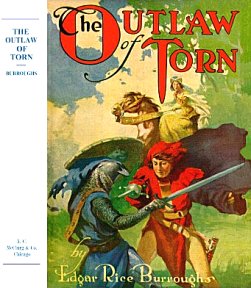 The dilemma is most clearly represented in ERB's second written book, The
Outlaw Of Torn. Outlaw is not a book he chose to write but
one which was suggested to him by his editor, Metcalf, at All Story Magazine.
ERB casts his story in his familiar Prince and Pauper format. His
mental dilemma is clearly depicted.
The dilemma is most clearly represented in ERB's second written book, The
Outlaw Of Torn. Outlaw is not a book he chose to write but
one which was suggested to him by his editor, Metcalf, at All Story Magazine.
ERB casts his story in his familiar Prince and Pauper format. His
mental dilemma is clearly depicted.
Norman, the hero, is the son of the English
king, Henry. Henry insults his fencing instructor De Vac who avenges
himself on Norman. The child is playing in a fenced yard attended
by his nurse, Maud, who represents his Anima. She is chatting with
a domestic failing to keep a close eye on Norman. He is lured through
the gate outside the garden (of Eden) where De Vac waits to kidnap him.
Realizing the boy's danger Maud rushes to Norman's rescue where De Vac
brutally murders her. Thus Norman/ERB's Anima is now destroyed.
The mind cannot exist without an Anima so De Vac takes the young boy to
London where they occupy the attic of a house over the Thames. The
river represents the waters of the feminine while the house represents
ERB and the attic his mind. Now, to replace the anima De Vac dresses
as an old woman associating with Norman in that guise until Norman/ERB’s
mind heals enough
for ERB to function. At that time De Vac shifts to the Animus
side training Norman in the manly arts. Thus Norman becomes a sort
of predecessor of Tarzan. Tarzan Of The Apes will be the third
novel ERB writes. At that point drawing on the clear example of Outlaw
Of Torn ERB began to evolve his way out of his psychological dilemma.
The reason he can never develop a relationship
with La is because she represents ERB’s failed Anima. In this scene
La is on her knees pleading with Tarzan to accept her love. Tarzan
coldly replies that he does not want her. Then walks away taking
Werper his alter ego with him.
The little hairy men come shrieking after them.
Tarzan’s heroic side clubs them down with his heavy war spear thus replicating
the blow he recieved in Toronto on his enemies, correcting that insult
and injury. Over and over the heavy war spear falls on head after
head. Werper, befitting a coward, follows Tarzan in his shadow as
it were clutching the sacred sacrifical knife of Opar.
Thus we have two knives. Tarzan’s father's
knife and the sacred knife of Opar as two sides to the same man.
The hairy men do not attack Werper out of respect for the sacred knife.
Werper discovers this. Reversing the role he precedes Tarzan waving
the sacred knife as the little hairy men part before them. I don’t have
an explanation of the sacred knife at this time.
The hairy men do not pursue them. Searching
for the exit they come upon a tribe of great apes. Not content with
having reenacted his traumas once ERB gains a little extra gratification
by having Tarzan challenged by a large bull much, once again, as John confronted
him on the street corner. Thus the apes may have an association with
John. Tarzan is ready for the ape:
Werper saw a hairy bull swing down from
a broken column and advance, stiff legged and bristling, toward the naked
giant. The yellow fangs were bared, angry snarls and barkings rumbled
threateningly through the thick and hanging lips….
But there was no battle. It ended as the
majority of such jungle encounters end- one of the boasters loses his nerve
and becomes suddenly interested in a blowing leaf, a beetle, or the lice
on his hairy stomach.
Notice how all these offensive types are hairy.
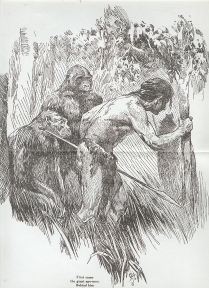
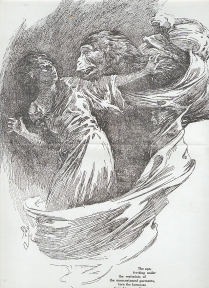
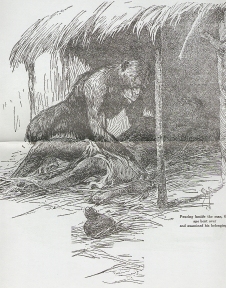
And so ERB caps the reliving of Toronto
and John. in his imagination he had corrected both encounters reversing
actuality to a more psychologically comfortable conclusion. But,
after all, it was just a fantasy and temporary fix. ERB would continue
to deal with the two traumas in an attempt to exorcize them. I don't
think he ever found a satisfactory resolution. In fact in a manner
Frank Martin continued the warfare from his grave to that of ERB.
After ERB died R.S. Patchin, Martin’s partner in crime, sent a letter
to John Coleman Burroughs in which he maliciously related the story
of the bashing or, in reality, attempted murder. Martin through Patchin
got the last laugh. Emma was dead by then anyway.

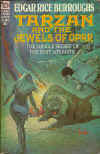
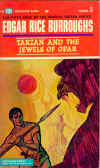
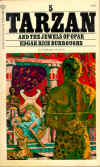
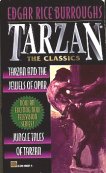
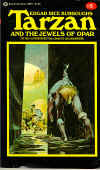
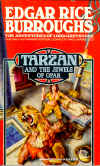
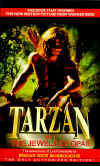
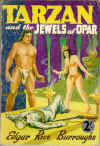
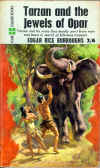
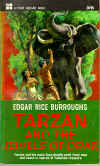
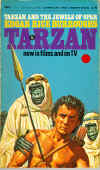

 Tarzan when locked in a cell on the previous occasion had removed the bricks
in the wall opening into this corridor. Werper now traces Tarzan’s
steps in reverse. Coming to the well he makes the same leap with
with same success. Removing the bricks he retraces Tarzan’s steps
back up into the sacrificial chamber. Here the little hairy men seize
him tossing him onto the altar where La awaits. Duplicating the sacrifical
scene with Tarzan she is about to plunge the knife into Werper’s breast
when the air is shattered by a deafening roar. A lion has announced
his presence in the chamber. The little hairy men flee, La faints
and Werper prays.
Tarzan when locked in a cell on the previous occasion had removed the bricks
in the wall opening into this corridor. Werper now traces Tarzan’s
steps in reverse. Coming to the well he makes the same leap with
with same success. Removing the bricks he retraces Tarzan’s steps
back up into the sacrificial chamber. Here the little hairy men seize
him tossing him onto the altar where La awaits. Duplicating the sacrifical
scene with Tarzan she is about to plunge the knife into Werper’s breast
when the air is shattered by a deafening roar. A lion has announced
his presence in the chamber. The little hairy men flee, La faints
and Werper prays.



















